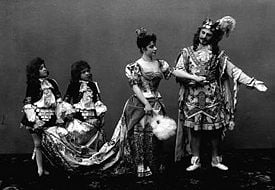Mariinsky Ballet
The Mariinsky Ballet, affiliated with the Mariinsky Theatre in St Petersburg, is one of the most famous ballet companies in history. The company was known as the Imperial Ballet until the early 20th century. Following the assassination of Sergei Kirov, they were renamed Kirov Ballet but reverted to the original name after the fall of the Communism.
It was for this company that the great choreographer Marius Petipa staged quintessential works of classical ballet, notably the revisions of Giselle, Swan Lake, Le Corsaire and the original ballets Raymonda, The Nutcracker, La Bayadere, Don Quixote, Harlequinade, and The Sleeping Beauty. Among the 20th-century ballets, Spartacus was inaugurated there in 1956.
Following the October Revolution of 1917, the ballet master Agrippina Vaganova determined to continue the traditions and methods of the Russian Imperial Ballet. Her method laid the groundwork for the formation and development of classical ballet in the world.
The choreography school of the Mariinsky Ballet, the Vaganova School, named after its most celebrated teacher, Agrippina Vaganova, prepared many of the greatest danseurs in history: Avdotia Istomina, Paul Gerdt, Olga Preobrajenska, Mathilde Kschessinska, Anna Pavlova, Tamara Karsavina, Mikhail Fokine, Olga Spesivtseva, Vaslav Nijinsky, George Balanchine, Lydia Lopokova, Galina Ulanova, Marina Semenova, Konstantin Sergeyev, Alla Shelest, Alla Sizova, Natalia Dudinskaya, Yury Grigorovich, Natalia Makarova, Rudolf Nureyev, Yuri Soloviev, Mikhail Baryshnikov, Irina Kolpakova, and in modern times, Altynai Asylmuratova, Diana Vishneva, Uliana Lopatkina, Svetlana Zakharova, Adrian Fadeev, Igor Kolb, Daria Pavlenko, Evgenia Obrazstova.
During the Cold War, however, the company faced the problem of some dancers refusing to return from Western countries they toured, while others were transferred by Soviet authorities to the Bolshoi Theatre in Moscow. In this way the company lost great dancers, such as Ulanova, Semenova, Nureyev, Makarova, and Baryshnikov.
External links
- Official site of the Vaganova Ballet Academy
- Site for the Mariinsky Ballet
- Additional Information/Pictures about the Mariinsky-Kirov Ballet
- More information and interviews from the Kirov Ballet
Credits
New World Encyclopedia writers and editors rewrote and completed the Wikipedia article in accordance with New World Encyclopedia standards. This article abides by terms of the Creative Commons CC-by-sa 3.0 License (CC-by-sa), which may be used and disseminated with proper attribution. Credit is due under the terms of this license that can reference both the New World Encyclopedia contributors and the selfless volunteer contributors of the Wikimedia Foundation. To cite this article click here for a list of acceptable citing formats.The history of earlier contributions by wikipedians is accessible to researchers here:
The history of this article since it was imported to New World Encyclopedia:
Note: Some restrictions may apply to use of individual images which are separately licensed.
